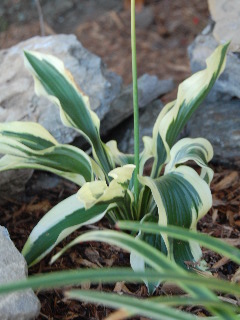
Hostas are herbaceous perennials, which means leafy plants without woody stems that come back year after year.
Gardeners love hostas for their showy leaves, with colorations from dark green to blue to yellowish-white and several variegated patterns of greens and lighter colors.
This variation in leaf color allows the gardener to design patterns within the landscape using clusters of all the same color or mixing clumps of one color variety with clumps of other color varieties, allowing for a flowing color palette of many shades of green.
And, even though hosta plants do produce blooms on stalks during the summer months, the plants are generally incorporated into the landscape for their showy leaves.
In terms of sun and shade requirements, hosta is primarily a shade-loving plant with ideal growing conditions being a mix of sun and shade during the morning hours followed by total shade throughout the afternoon.
Too much direct sun will burn the leaves while too much shade will result in poor growth performance for the plants.
Work your hostas into your planting bed keeping in mind their own beautiful leaf color variations while at the same time thinking of how their colors can be blended in with other plants—particularly other herbaceous perennials such as liriope and seasonal annuals whose blooms can really add a bright boost of colors to complement the mixture of leafy greens.
Plant hostas in a good organic soil mixture allowing plenty of room in the ground for root development as well as room up above for the leaves to spread and flourish.
Take note of the varieties of hostas you are planting to see what their spreading and growth requirements are. This will allow the maximum show of the leafy green surfaces in your garden without the plants appearing crowded.
Use a balanced plant food when planting hostas, and then feed again lightly in the late spring or early summer.

Don’t add fertilizer as the summer growing season is ending—during this time the hostas are slowing their growth as they prepare to enter the winter dormancy. Fertilizing in the late summer can stimulate much tender growth that would be adversely affected by the coming cold weather.
Keep your hostas watered sufficiently during the heat of summer—adding a good supply of organic mulch on top of the ground will help retain moisture to the roots.
Cut off the bloom stems after flowering is finished, and remove dead and dying leaves from the hosta plants as they head into dormancy.
Keeping the planting bed clean and free of dead vegetation also aids in the prevention of disease and allows less cover and food for unwanted pests.
If your hosta plants grow so vigorously that they become too thick or crowded, it’s a simple matter to dig up a hosta clump and divide it into two or more plants to be re-set into the garden with more room to grow and show. Just be sure each of the newly divided clumps has sufficient root structure to insure the healthy growth of the new plant.
 Hostas are herbaceous perennials, which means leafy plants without woody stems that come back year after year.
Hostas are herbaceous perennials, which means leafy plants without woody stems that come back year after year.
 Don’t add fertilizer as the summer growing season is ending—during this time the hostas are slowing their growth as they prepare to enter the winter dormancy. Fertilizing in the late summer can stimulate much tender growth that would be adversely affected by the coming cold weather.
Don’t add fertilizer as the summer growing season is ending—during this time the hostas are slowing their growth as they prepare to enter the winter dormancy. Fertilizing in the late summer can stimulate much tender growth that would be adversely affected by the coming cold weather.